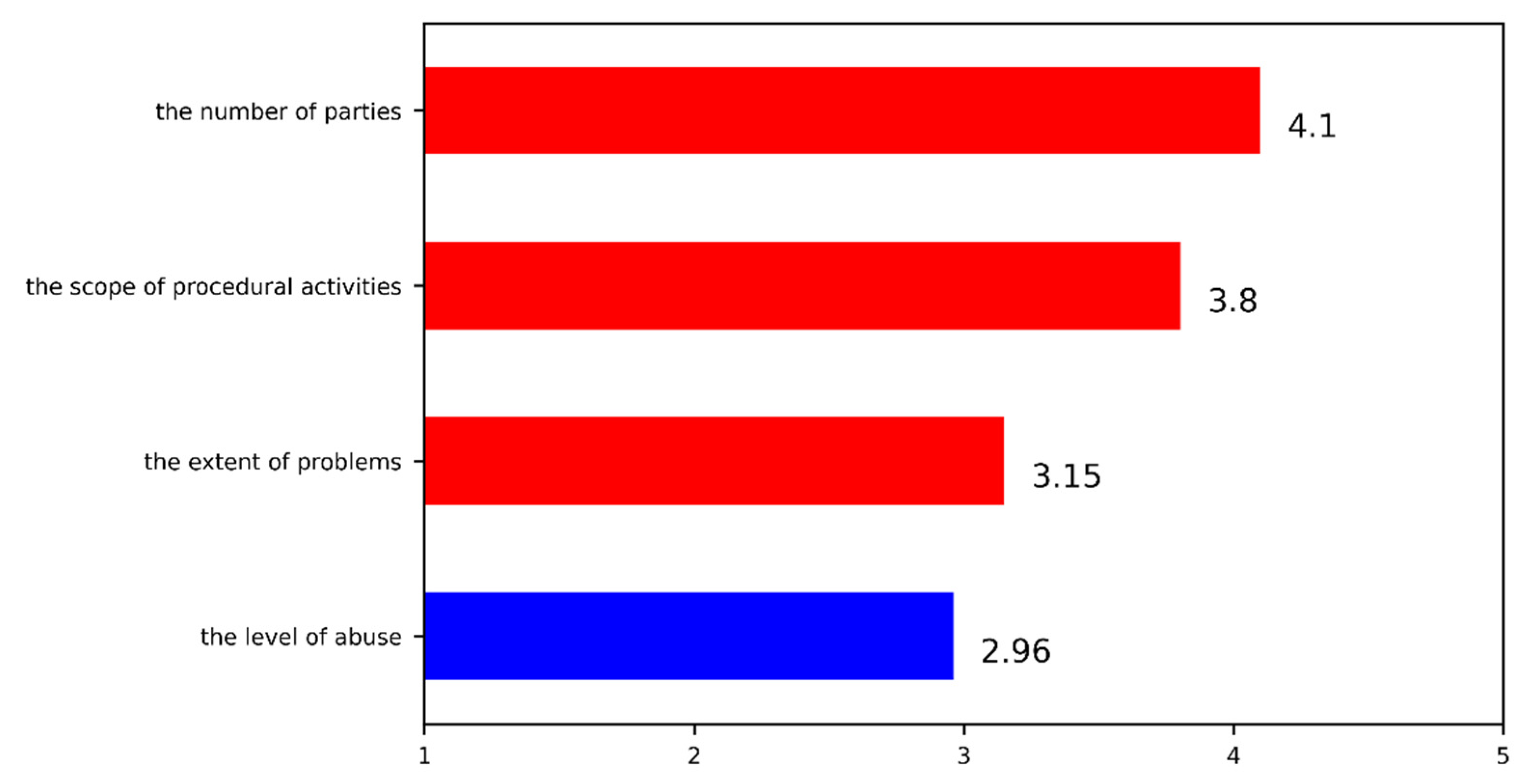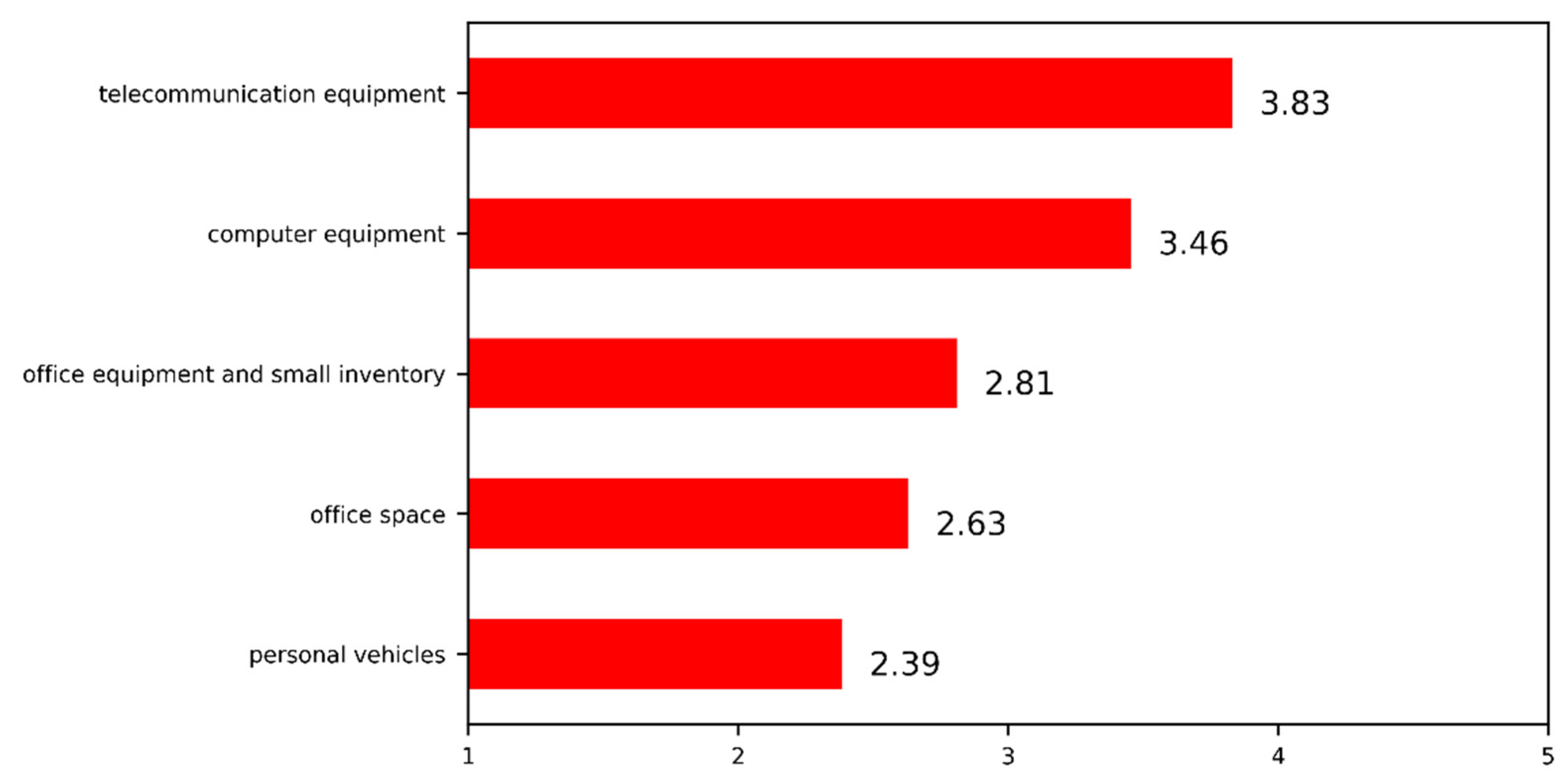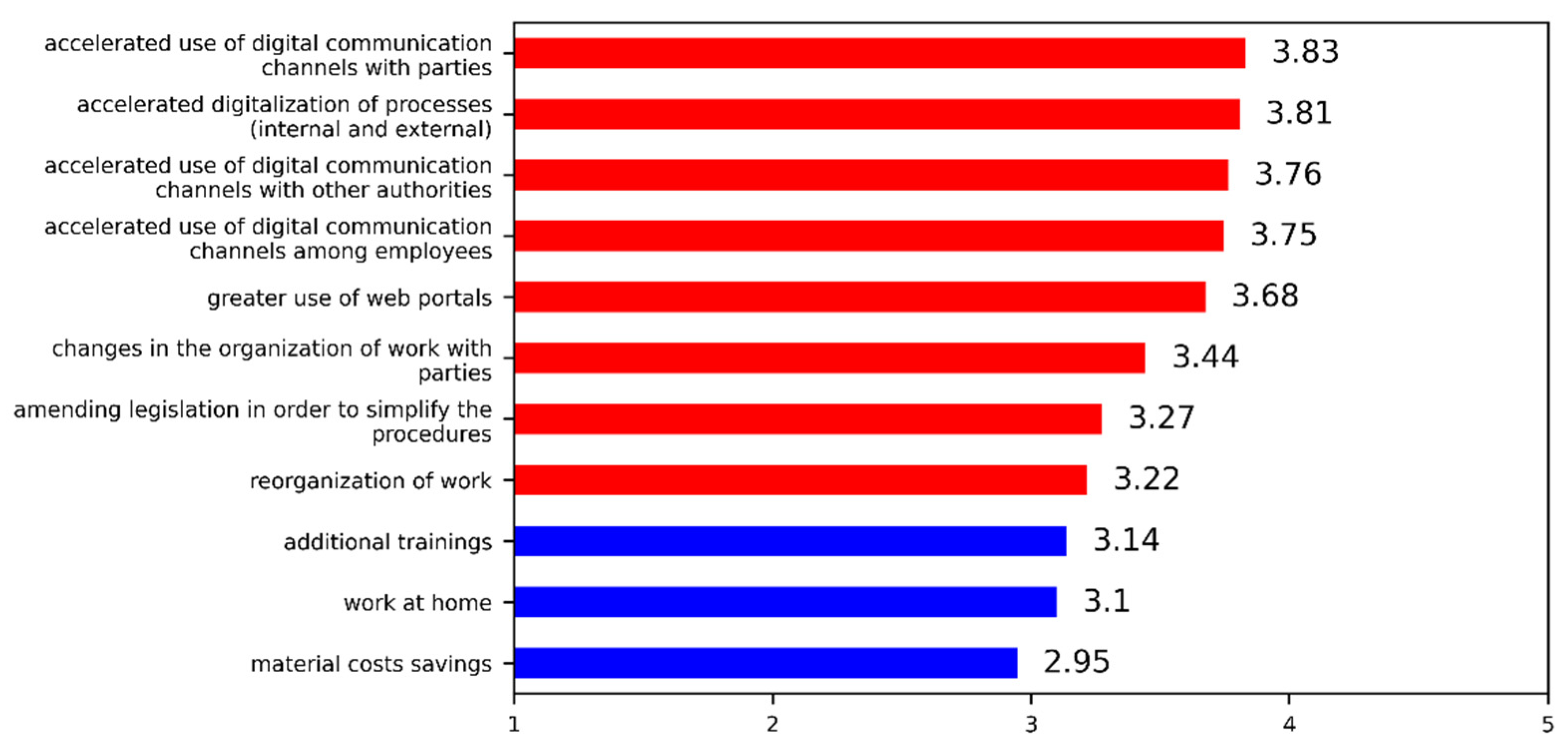The Use of ICT by Local General Administrative Authorities during COVID-19 for a Sustainable Future: Comparing Five European Countries
Abstract
:1. Introduction
2. Materials and Methods
2.1. Study Participants and Procedure
2.2. Measures
2.3. Statistical Analysis
3. Results
3.1. Overview of the Questionnaire Findings
3.1.1. Regulations and Competences of Administrative Authorities during COVID-19
3.1.2. Procedures and Services during COVID-19
3.1.3. Challenges for Public Managers during COVID-19
3.1.4. Cost Management during COVID-19
3.1.5. Future Challenges after COVID-19
3.2. Regression Results
4. Discussion
5. Conclusions
Author Contributions
Funding
Institutional Review Board Statement
Informed Consent Statement
Data Availability Statement
Acknowledgments
Conflicts of Interest
References
- Kuhlmann, S.; Bouckaert, G.; Galli, D.; Reiter, R.; Hecke, S.V. Opportunity management of the COVID-19 pandemic: Testing the crisis from a global perspective. Int. Rev. Adm. Sci. 2021. [Google Scholar] [CrossRef]
- OECD. The Territorial Impact of COVID-19: Managing the Crisis across Levels of Government. Available online: https://www.oecd.org/coronavirus/policy-responses/the-territorial-impact-of-COVID-19-managing-the-crisis-across-levels-of-government-d3e314e1/ (accessed on 15 June 2021).
- UNDP. Sustainable Development Goals. Available online: https://www.undp.org/sustainable-development-goals (accessed on 29 May 2021).
- Leal Filho, W.; Brandli, L.L.; Lange Salvia, A.; Rayman-Bacchus, L.; Platje, J. COVID-19 and the UN sustainable development goals: Threat to solidarity or an opportunity? Sustainability 2020, 12, 5343. [Google Scholar] [CrossRef]
- European Commission. Communication from the Commission to the European Parliament, the Council, the European Economic and Social Committee and the Committee of the Regions. Available online: https://ec.europa.eu/clima/sites/clima/files/adaptation/what/docs/eu_strategy_2021.pdf (accessed on 1 August 2021).
- World in 2050 Initiative. The Digital Revolution and Sustainable Development: Opportunities and Challenges. Int. Inst. Appl. Syst. Anal. 2019, 3. [Google Scholar] [CrossRef]
- Onan, A.; Korukoğlu, S.; Bulut, H. A hybrid ensemble pruning approach based on consensus clustering and multi-objective evolutionary algorithm for sentiment classification. Inf. Process. Manag. 2017, 53, 814–833. [Google Scholar] [CrossRef]
- Sachs, J.D.; Schmidt-Traub, G.; Mazzucato, M.; Messner, D.; Nakicenovic, N.; Rockström, J. Six transformations to achieve the sustainable development goals. Nat. Sustain. 2019, 2, 805–814. [Google Scholar] [CrossRef]
- Wallace, H.; Pollack, M.A.; Roederer-Rynning, C.; Young, A.R. Policymaking in the European Union, 8th ed.; Oxford University Press: Oxford, UK, 2020; p. 471. [Google Scholar]
- Esses, D.; Csete, M.S.; Németh, B. Sustainability and Digital Transformation in the Visegrad Group of Central European Countries. Sustainability 2021, 13, 5833. [Google Scholar] [CrossRef]
- Agostino, D.; Arnaboldi, M.; Diaz Lema, M. New development: COVID-19 as an accelerator of digital transformation in public service delivery. Public Money Manag. 2021, 41, 69–72. [Google Scholar] [CrossRef]
- Gabryelczyk, R. Has COVID-19 Accelerated Digital Transformation? Initial Lessons Learned for Public Administrations. Inf. Syst. Manag. 2020, 37, 303–309. [Google Scholar] [CrossRef]
- OECD. Public Administration: Responding to the COVID-19 Pandemic. Available online: http://sigmaweb.org/byexpertise/strategicframeworkofpublicadministrationreform/SIGMA-mapping-response-EU-members-coronavirus.pdf (accessed on 7 July 2021).
- Meuleman, L. Public Administration and Governance for the SDGs: Navigating between Change and Stability. Sustainability 2021, 13, 5914. [Google Scholar] [CrossRef]
- Hodžić, S.; Ravšelj, D.; Alibegović, D.J. E-Government Effectiveness and Efficiency in EU-28 and COVID-19. Cent. Eur. Public Adm. Rev. 2021, 19, 159–180. [Google Scholar] [CrossRef]
- Křížová, T. Digitalization and remote communication with the tax administrator in the time of Covid and post-covid. Annu. Cent. Rev. 2020, 12–13, 54–59. [Google Scholar] [CrossRef]
- Toleikienė, R.; Rybnikova, I.; Juknevičienė, V. Whether and how does the Crisis-Induced Situation Change e-Leadership in the Public Sector? Evidence from Lithuanian Public Administration. Transylv. Rev. Adm. Sci. 2020, 16, 149–166. [Google Scholar]
- Iida, J. Digital transformation vs COVID-19: The case of Japan. Dig. Law J. 2020, 1, 8–16. [Google Scholar] [CrossRef]
- Caron, D.J.; Desrochers, P.R. Canadian Federal Public Administration and the COVID-19 Crisis: Lessons to Be Learned for the Upcoming Digital Transformation; Chaire de Recherche en Exploitation des Ressources Informationnelles; École Nationale D’administration Publique (ENAP): Québec, QC, Canada, 2020. [Google Scholar]
- Etikan, I.; Musa, S.A.; Alkassim, R.S. Comparison of convenience sampling and purposive sampling. Am. J. Theor. Appl. Stat. 2016, 5, 1–4. [Google Scholar] [CrossRef] [Green Version]
- Little, R.J.; Rubin, D.B. Statistical Analysis with Missing Data; John Wiley & Sons: Hoboken, NJ, USA, 2019; Volume 793. [Google Scholar]
- Eekhout, I.; de Boer, R.M.; Twisk, J.W.; de Vet, H.C.; Heymans, M.W. Missing data: A systematic review of how they are reported and handled. Epidemiology 2021, 23, 729–732. [Google Scholar] [CrossRef] [PubMed]
- Dong, Y.; Peng, C.Y.J. Principled missing data methods for researchers. SpringerPlus 2013, 2, 1–17. [Google Scholar] [CrossRef] [Green Version]
- Aristovnik, A.; Keržič, D.; Ravšelj, D.; Tomaževič, N.; Umek, L. Impacts of the COVID-19 Pandemic on Life of Higher Education Students: A Global Perspective. Sustainability 2020, 12, 8438. [Google Scholar] [CrossRef]
- Croasmun, J.T.; Ostrom, L. Using Likert-Type Scales in the Social Sciences. J. Adult Edu. 2011, 40, 19–22. [Google Scholar]
- McKinney, W. Python for Data Analysis: Data Wrangling with Pandas, NumPy, and IPython; O’Reilly Media, Inc.: Newton, MA, USA, 2012. [Google Scholar]
- Ross, A.; Willson, V.L. One-sample T-test. In Basic and Advanced Statistical Tests; Sense: Rotterdam, The Netherlands, 2017; pp. 9–12. [Google Scholar]
- Streiner, D.L.; Norman, G.R. Correction for multiple testing: Is there a resolution? Chest 2011, 140, 16–18. [Google Scholar] [CrossRef]
- Seabold, S.; Perktold, J. Statsmodels: Econometric and statistical modeling with python. In Proceedings of the 9th Python in Science Conference, Austin, TX, USA, 28 June–3 July 2010; Volume 57, p. 61. [Google Scholar]
- Houston, D.J. Public-service motivation: A multivariate test. J. Public Adm. Res. Theory 2000, 10, 713–728. [Google Scholar] [CrossRef]
- Harrell, F.E. Ordinal logistic regression. In Regression Modeling Strategies; Springer: Cham, Switzerland, 2015; pp. 311–325. [Google Scholar]
- Cohen, J.; Cohen, P.; West, S.G.; Aiken, L.S. Applied Multiple Regression/Correlation Analysis for the Behavioral Sciences; Routledge: Abingdon-on-Thames, UK, 2013. [Google Scholar]
- Ong, M.H.A.; Puteh, F. Quantitative data analysis: Choosing between SPSS, PLS, and AMOS in social science research. Int. Interdiscip. J. Sci. Res. 2017, 3, 14–25. [Google Scholar]
- Sigma. Public Administration: Responding to the COVID-19. Available online: http://www.sigmaweb.org/publications/SIGMA-mapping-public-administration-response-EU-members-coronavirus-COVID19.pdf (accessed on 20 May 2021).
- Bouckaert, G.; Galli, D.; Kuhlmann, S.; Reiter, R.; Van Hecke, S. European coronationalism? A hot spot governing a pandemic crisis. Pubic Adm. Rev. 2020, 80, 765–773. [Google Scholar] [CrossRef] [PubMed]
- Roblek, V.; Bach, M.P.; Meško, M.; Bertoncel, T. Best practices of the social innovations in the framework of the e-government evolution. Amfiteatru Econ. 2020, 22, 275–302. [Google Scholar] [CrossRef]
- Streimikiene, D.; Mikalauskiene, A.; Digriene, L.; Kyriakopoulos, G. Assessment of the Role of a Leader in Shaping Sustainable Organizational Culture. Amfiteatru Econ. 2021, 23, 483–503. [Google Scholar]
- van Acker, W.; Bouckaert, G. What Makes Public Sector Innovations Survive? An Exploratory Study of the Influence of Feedback, Accountability and Learning. Int. Rev. Adm. Sci. 2017, 84, 249–268. [Google Scholar] [CrossRef]
- Misuraca, G.; Barcevičius, E.; Codagnone, C. Exploring Digital Government Transformation in the EU. In Analysis of the State of the Art and Review of Literature; Publications Office of the EU: Luxembourg, 2019. [Google Scholar]
- Windholz, E.L. Governing in a pandemic: From parliamentary sovereignty to autocratic technocracy. Theory Pract. Leg. 2020, 8, 93–113. [Google Scholar] [CrossRef]
- Kovač, P. Debureaucratization Limits in Administrative Procedures Codification: Lessons from Slovenia. Adm. Sci. 2021, 11, 1. [Google Scholar] [CrossRef]
- ReNEUAL Model Rules on EU Administrative Procedure; Craig, P.P.; Hofmann, H.; Schneider, J.P.; Ziller, J. (Eds.) Oxford University Press: Oxford, UK, 2017. [Google Scholar]
- Schuster, C.; Weitzman, L.; Sass Mikkelsen, K.; Meyer-Sahling, J.; Bersch, K.; Fukuyama, F.; Paskov, P.; Rogger, D.; Mistree, D.; Kay, K. Responding to COVID-19 through Surveys of Public Servants. Pubic Adm. Rev. 2020, 80, 792–796. [Google Scholar] [CrossRef] [PubMed]
- European Commission. Digital Economy and Society Index (DESI) Report 2020—Digital Public Services; European Commission: Brussels, Belgium, 2020. [Google Scholar]
- Menard, S. Applied Logistic Regression Analysis, 2nd ed.; SAGE Publications, Inc.: Thousand Oaks, CA, USA; Sam Houston State University: Huntsville, TX, USA; University of Colorado: Boulder, CO, USA, 2002; Volume 106. [Google Scholar]
- Alin, A. Multicollinearity. Wiley Interdiscip. Rev. Comput. Stat. 2010, 2, 370–374. [Google Scholar] [CrossRef]
- Nagelkerke, N.J. A note on a general definition of the coefficient of determination. Biometrika 1991, 78, 691–692. [Google Scholar] [CrossRef]
- Kovač, P.; Bileišis, M. (Eds.) Public Administration Reforms in Eastern European Union Member States: Post-Accession Convergence and Divergence; Faculty of Public Administration, Mykolas Romeris University: Vilnius, Ljubljana, 2017. [Google Scholar]
- Mergel, I.; Ganapati, S.; Whitford, A.B. Agile: A new way of governing. Public Adm. Rev. 2021, 81, 161–165. [Google Scholar] [CrossRef]
- Ansell, C.; Sørensen, E.; Torfing, J. The COVID-19 pandemic as a game changer for public administration and leadership? The need for robust governance responses to turbulent problems. Public Manag. Rev. 2020, 23, 949–960. [Google Scholar] [CrossRef]
- Hamouche, S. Human resource management and the COVID-19 crisis: Implications, challenges, opportunities, and future organizational directions. J. Manag. Organ. 2021, 1–16. [Google Scholar] [CrossRef]
- Koirala, J.; Acharya, S. Dimensions of human resource management evolved with the outbreak of COVID-19. SSRN Electron. J. 2020, 1–8. [Google Scholar] [CrossRef]
- Boin, A.; Brock, K.; Craft, J.; Halligan, J.; ‘t Hart, P.; Roy, J.; Tellier, G.; Turnbull, L. Beyond COVID-19: Five commentaries on expert knowledge, executive action, and accountability in governance and public administration. Can. Public Adm. 2020, 63, 339–368. [Google Scholar] [CrossRef]
- Kovač, P.; Umek, L.; Ravšelj, D.; Aristovnik, A. Impact of COVID-19 on the digitalisation of administrative procedures: Lessons from Slovenian administrative units. Teorija Praksa 2021, 58, 652–669. [Google Scholar] [CrossRef]





| Socio-Demographic and Geographic Characteristics | Number (%) |
|---|---|
| Years of employment | |
| less than 1 year | 44 (6.8) |
| 1–5 years | 201 (31.1) |
| 6–10 years | 141 (21.8) |
| 11–15 years | 103 (15.9) |
| 16–20 years | 72 (11.1) |
| more than 20 years | 86 (13.3) |
| Years of work experience | |
| less than 10 years | 39 (5.9) |
| 11–20 years | 159 (24.0) |
| 21–30 years | 262 (39.5) |
| 31–40 years | 203 (30.6) |
| Size of general administrative authority (no. of employees) | |
| less than 20 | 54 (8.0) |
| 21–40 | 101 (14.9) |
| 41–60 | 46 (6.8) |
| 61–80 | 5 (0.7) |
| 81–100 | 144 (21.2) |
| more than 100 | 328 (48.4) |
| Size of the general administrative authority (no. of inhabitants) | |
| small administrative authority (up to 18,000 inhabitants) | 143 (40.5) |
| medium administrative authority (18,000–50,000 inhabitants) | 19 (5.4) |
| large administrative authority (50,000–100,000 inhabitants) | 71 (20.1) |
| one of the largest administrative authorities (over 100,000 inhabitants) | 120 (34.0) |
| Coverage area of the general administrative authority | |
| predominantly urban area | 231 (34.3) |
| predominantly rural area | 442 (65.7) |
| Country | |
| Czech Republic | 60 (6.5) |
| Germany | 109 (11.8) |
| Poland | 420 (45.4) |
| Romania | 279 (30.1) |
| Slovenia | 58 (6.3) |
| Variables | (1) | (2) | (3) | (4) | (5) | (6) | (7) | (8) | (9) |
|---|---|---|---|---|---|---|---|---|---|
| (1) Accelerated digitalization after the COVID-19 pandemic | 1.000 | ||||||||
| (2) Regulation clarity—unambiguity | 0.071 * | 1.000 | |||||||
| (3) Regulation inconsistency | 0.059 | 0.043 | 1.000 | ||||||
| (4) Use of simplified digitalized procedures by parties | 0.280 *** | 0.033 | 0.094 ** | 1.000 | |||||
| (5) Abuses of digitalized procedures | −0.069 * | −0.008 | 0.056 | −0.008 | 1.000 | ||||
| (6) Difficult work coordination in the absence of staff | 0.140 *** | −0.134 *** | 0.004 | 0.169 *** | 0.094 ** | 1.000 | |||
| (7) Opportunity to digitalize work processes | 0.362 *** | 0.082 | 0.062 * | 0.350 *** | 0.024 | 0.215 *** | 1.000 | ||
| (8) Computer equipment utilization | 0.292 *** | 0.027 | 0.067 * | 0.134 ** | −0.038 | 0.054 | 0.175 *** | 1.000 | |
| (9) Telecommunication equipment utilization | 0.273 *** | −0.052 | 0.083 ** | 0.193 *** | −0.006 | 0.178 *** | 0.234 *** | 0.647 *** | 1.000 |
| Dependent Variable: Accelerated Digitalization after the COVID-19 Pandemic a | B | SE | Wald | Sig. | OR |
|---|---|---|---|---|---|
| Regulation clarity—unambiguity a | 0.198 * | 0.114 | 2.994 | 0.084 | 1.219 |
| Regulation inconsistency a | −0.185 * | 0.109 | 2.869 | 0.090 | 0.831 |
| Use of simplified digitalized procedures by parties a | 0.410 ** | 0.163 | 6.357 | 0.012 | 1.507 |
| Abuses of digitalized procedures a | −0.227 | 0.158 | 2.063 | 0.151 | 0.797 |
| Difficult work coordination in the absence of staff a | 0.668 *** | 0.146 | 21.026 | 0.000 | 1.950 |
| Opportunity to digitalize work processes a | 0.687 *** | 0.170 | 16.402 | 0.000 | 1.989 |
| Computer equipment utilization a | 0.327 ** | 0.162 | 4.067 | 0.044 | 1.387 |
| Telecommunication equipment utilization a | 0.347 * | 0.183 | 3.615 | 0.057 | 1.415 |
| Germany b | 1.294 *** | 0.415 | 9.719 | 0.002 | 3.647 |
| Poland b | 0.684 | 0.553 | 1.527 | 0.217 | 1.981 |
| Romania b | 1.514 *** | 0.339 | 19.974 | 0.000 | 4.544 |
| Slovenia b | −0.029 | 0.406 | 0.005 | 0.943 | 0.971 |
Publisher’s Note: MDPI stays neutral with regard to jurisdictional claims in published maps and institutional affiliations. |
© 2021 by the authors. Licensee MDPI, Basel, Switzerland. This article is an open access article distributed under the terms and conditions of the Creative Commons Attribution (CC BY) license (https://creativecommons.org/licenses/by/4.0/).
Share and Cite
Aristovnik, A.; Kovač, P.; Murko, E.; Ravšelj, D.; Umek, L.; Bohatá, M.; Hirsch, B.; Schäfer, F.-S.; Tomaževič, N. The Use of ICT by Local General Administrative Authorities during COVID-19 for a Sustainable Future: Comparing Five European Countries. Sustainability 2021, 13, 11765. https://doi.org/10.3390/su132111765
Aristovnik A, Kovač P, Murko E, Ravšelj D, Umek L, Bohatá M, Hirsch B, Schäfer F-S, Tomaževič N. The Use of ICT by Local General Administrative Authorities during COVID-19 for a Sustainable Future: Comparing Five European Countries. Sustainability. 2021; 13(21):11765. https://doi.org/10.3390/su132111765
Chicago/Turabian StyleAristovnik, Aleksander, Polonca Kovač, Eva Murko, Dejan Ravšelj, Lan Umek, Marie Bohatá, Bernhard Hirsch, Fabienne-Sophie Schäfer, and Nina Tomaževič. 2021. "The Use of ICT by Local General Administrative Authorities during COVID-19 for a Sustainable Future: Comparing Five European Countries" Sustainability 13, no. 21: 11765. https://doi.org/10.3390/su132111765
APA StyleAristovnik, A., Kovač, P., Murko, E., Ravšelj, D., Umek, L., Bohatá, M., Hirsch, B., Schäfer, F.-S., & Tomaževič, N. (2021). The Use of ICT by Local General Administrative Authorities during COVID-19 for a Sustainable Future: Comparing Five European Countries. Sustainability, 13(21), 11765. https://doi.org/10.3390/su132111765








